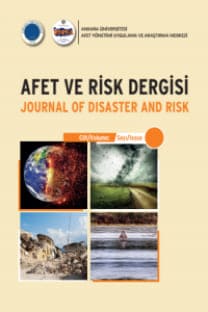Kimyasal Silahlara Yönelik Olarak Alınan Önlemlerin Kimyasal Silahlar Sözleşmesi Perspektifinde Değerlendirilmesi
Evaluation of Preventions for Chemical Weapons by The Perspective of The Chemical Weapons Convention
___
- Alsan, Z. (1950). 1949 Cenevre Sözleşmeleri. Ankara: s.46-47.
- Bassiouni, M.C. (2008). The new wars and the crisis of compliance with the law of armed conflict by non-state actors. J. Criminal Law Criminology, 98, 711-810.
- Belik, M. (1956). Devletlerin Harp Salahiyetlerinin Tahdidi ve Milletlerarası İhtilafların Sulh Yolu ile Halli Usulleri. İstanbul: s.13.
- URL 1, https:// www.unog.ch (Son Erişim Tarihi: 12.03.2020)
- Boethe, M. (1998). The New Chemical Weapons Implementation and Prospects. Hollanda: s. 591-595.
- Boulden, J. (2014). Multilateral institutions/regimes and the dissemination of WMD. Globalisation, Multilateralism. Europe: Towards a Better Global Governance, s. 361-372.
- Carpenter, W. (1993). The Perspective of the Western Chemical Industry” Shadows and Substance: The Chemical Weapons Convention. ABD: s.118.
- URL 2, https://www.opcw.org/about-opcw/conference-of-the-states-parties/about-the-conference-of-the-states-parties (Son Erişim Tarihi: 15.03.2020)
- Cooper, G. (1992). The Chemical Weapons Convention verification regime. UNIDIR Newslett, 20, 11.
- Dewing, M. (2014). Terrorism and chemical security: Small quantities of chemicals of interest. J.Appl. Secur. Res., 9, 81-96.
- Diltemiz, S., Yağmuroğlu, O. (2019). Development of reflectometric interference spectroscopy based sensors for paraoxon determination. Eskişehir Technical University Journal of Science and Technology - C Life Sciences and Biotechnology, 8 (1), 12-22.
- Erdurmaz, A. (2003). Orta Doğu’daki Kitle İmha Silahları Silahların Kontrolü ve Türkiye. Ankara: s.117.
- Glasstone, S. (1977). The Effects On Nuclear Weapons. Washington DC.: US Defence and US Department of Energy Press.
- Gönlübol, M. (1975). Milletlerarası Siyasi Teşkilatlanma. Ankara: s.64.
- Graham, H. (1992). The Chemical Weapons Convention verification regime. UNIDIR Newslett, 20,11.
- Iannotti, M.C., Schraffl, I., Bellecci, C., Malizia, A., Cenciarelli, O., Di Giovanni, D., Palombi, L., Gaudio, P. (2016).
- Karataş, S. (2014). Uluslararası hukukta silahsızlanma ve kimyasal silahların yasaklanması örgütü (OPCW). (Yayımlanmamış Yüksek Lisans Tezi). Selçuk Üniversitesi, Konya.
- Kellman, B. (2015). The Advent of International Chemical Regulation: The Chemical Weapons Convention Implementation. Act .J. Legislation, 25, 117-139.
- Kenyon, R. (2007). OPCW: The Creation of the Organisation for the Prohibition of Chemical Weapons, A Case Study in the Birth of an Intergovernmental Organisation. Hollanda.
- Marauhn, T. (2016). The prohibition to use chemical weapons. Yearbook of International Humanitarian Law, 17, 25-44.
- Mashhadi, H. (1992). How the negotiations ended. Chemical Weapons Conventions Bulletin, No:17.
- URL 3, https://www.opcw.org/about-opcw/executive-council/membership-and-functions (Son Erişim Tarihi: 19.03.2020) Organisation for the Prohibition of Chemical Weapons. 30 Eylül 2019’da www.opcw.org/about-opcw/executive-council/membership-and-functions adresinden alınmıştır.
- Önder, O. (2006). Birleşmiş Milletler Ruanda için Uluslararası Ceza Mahkemesi. Ankara: s.54.
- Özgür, S. (2006). Soğuk Savaş ve Sonrası Dönemde Kitle İmha Silahları ve Silahsızlanma Çabaları. (Yayımlanmamış Yüksek Lisans Tezi). Süleyman Demirel Üniversitesi, Isparta.
- Robinson, J. (1993). The Chemical Weapons Convention: The success of chemical disarmament negotiations. İsviçre: s. 714.
- Selcen, E. (2010). Uluslararası Ceza Mahkemesinin Devlet Egemenliğine Etkisi. Ankara: s.105.
- Solis, D. (2010). The Law of Armed Conflict International Humanitarian Law in War. New York.
- Some methods of monitoring compliance with an agreement on the prohibition of chemical Weapons. (1976). CCD/558.
- Stern, J. (1993). All’s well that ends well? Verification and the CWC. İngiltere: Peacekeeping and the Environment.
- Thakur, R. (2006). The chemical weapon convention. Implementation Challenges and Opportunities. Hong Kong: United Nations University Press.
- Üzümcü, A. (2014). The Chemical Weapons Convention-disarmament, science and technology. Anal.Bioanal.Chem., 406, 5071-5073.
- Wagner, V. (2000). Lessons Learned. Hollanda:OPCW Synthesis.
- Willem, J. (2009). International Institutional Reform, 1st Edition. Tilburg/Hollanda: s.126-130.
- Yağmuroğlu, O. (2017). Development of paraoxon-based sensors for the detection of chemical warfare agents. Doctoral Thesis. Anadolu University, Eskişehir.
- Yağmuroğlu, O. (2018). Kimyasal Savunma ve Güvenlik. Eskişehir: Anadolu Üniversitesi Basımevi, s.3,30
- Yağmuroğlu, O., Diltemiz, SE. (2020a). Development of QCM based biosensor for the selective and sensitive detection of paraoxon. Analytical Biochemistry, 591, 113572.
- Yağmuroğlu, O. (2020b). Adsorption and Decomposition of Chemical Warfare Agents by Metal-Organic Framework. Biomedical Journal of Scientific & Technical Research, 26(1). https://doi.org/10.26717/bjstr.2020.25.004306
- Yağmuroğlu, O. (2020c). Kimyasal silahlarda kullanılan sinir ajanlarının tespitine yönelik nano ache enzim sistemi temelli sensör geliştirilmesi. Gazi Üniversitesi Fen Bilimleri Dergisi Part C: Tasarım ve Teknoloji, 8(1), 205–223.
- Yenisey, F. (2007). Uluslararası Ceza Mahkemesi’nin Yargı Yetkisi. İstanbul: s.123-135.
- Yayın Aralığı: 4
- Başlangıç: 2018
- Yayıncı: Ankara Üniversitesi
Altın ve Gümüş Madenciliğinde Siyanür Kaynaklı Kimyasal Kazalarda Acil Durum Yönetimi Örneği
Bülent BÜYÜKKIDAN, Hüseyin GÜMÜŞ
Kayseri İli Yapısal Yangınların İncelenmesi
Türkiye’de Acil Yıkım Yönetim Sistemi: Temel Yaklaşımlar, Elazığ Deprem Deneyimi Ve Öneriler
Bahatti̇n Murat DEMİR, Sami ERCAN, Mustafa AKTAN, Harun ÖZTAŞKIN
Afet Risklerinin Azaltılmasında Sivil İnsiyatiflerin Rolü: TRI DRR Örneği
Alpaslan Hamdi KUZUCUOGLU, Burçak BAŞBUĞ ERKAN
Mehmet Oğuzhan GÜREL, Halim Ferit BAYATA, Osman Ünsal BAYRAK
Türkiye’de Anti Nükleer Hareket Örneğinde Risk Söylemi
Amazon Nehri Havzası’nda Sürdürülebilir Sosyoekonomik Kalkınmayı Tehdit Eden Unsurlar
